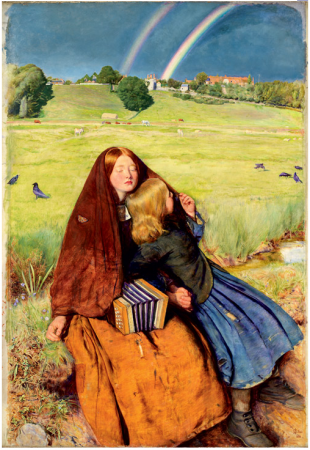
You have until 13 January to see the Tate's latest blockbuster: a seven room survey of the entire career of Sir John Everett Millais (1829-96), perhaps best known for his Ophelia and 'Bubbles' the Pears soap boy.
The greatest painter of his day produced what was then regarded as his greatest painting in 1854-6. The blind girl is a colossally garish exercise in high Victorian sentimentality. Patronisingly, we are asked to sympathise with the poor blind girl, who is unable to appreciate the sudden brilliant sunshine and rainbow that decorates a lead-grey Winchelsea sky. The two girls are awkwardly plonked down on a stream bank and (like several other of his paintings of the time) seem about to separate from the background. The 'pathetic' scene is completed with an improbably applied butterfly on the blind girl's right arm (delicate beauty she will never appreciate) and a toybox collection of country creatures which is randomly strewn across the irridescent meadow behind them.
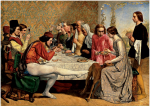 Isabella (1848-9) was Millais first painting as a member of the Pre-Raphaelite Brotherhood. It is both unsettling and unsatisfying. On the right a pink tunic wearing Lorenzo offers fruit to his Isabella, whilst a disapproving servant looks on. Lorenzo's face looks cut out and is curiously lit. On the left Millais casts some of his own friends, the affectionate reality of their portraits at odds with the fantasy scene across the table from them.
Isabella (1848-9) was Millais first painting as a member of the Pre-Raphaelite Brotherhood. It is both unsettling and unsatisfying. On the right a pink tunic wearing Lorenzo offers fruit to his Isabella, whilst a disapproving servant looks on. Lorenzo's face looks cut out and is curiously lit. On the left Millais casts some of his own friends, the affectionate reality of their portraits at odds with the fantasy scene across the table from them.
But it's not all bad. Millais was indisputedly an incredibly talented and highly precocious artist and draftsman. That we find his themed works not to our taste is perhaps because they were the soap operas of their day. We get these kicks from Eastenders and Corrie.
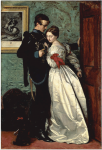 The Black Brunswicker (1859-60) is another exercise in popullist melodrama, only this time Millais has resoundingly pulled it off. On the eve of Waterloo a soldier departs to his death. Agonised, his wife tries to prevent his departure, her hand pushing the door closed as he opens it. As she gazes sadly at her imploring lapdog, an etching of Napoleon hangs behind them. The painting is quite sumptuous, the composition perfectly suited to its remorseless narrative. The work sold for 1,000 guineas and made Millais' reputation.
The Black Brunswicker (1859-60) is another exercise in popullist melodrama, only this time Millais has resoundingly pulled it off. On the eve of Waterloo a soldier departs to his death. Agonised, his wife tries to prevent his departure, her hand pushing the door closed as he opens it. As she gazes sadly at her imploring lapdog, an etching of Napoleon hangs behind them. The painting is quite sumptuous, the composition perfectly suited to its remorseless narrative. The work sold for 1,000 guineas and made Millais' reputation.
 By 1864 Millais' style had evolved considerably. In 'Leisure Hours' (the quotation marks are the painter's) he has painted the Pender sisters as perfect ornaments, trapped in enforced idleness just as much as the goldfish in the bowl in front of them. The paintwork is a little looser and without distractions. The blank stares and suffocating stillness of the composition all add to the narrative, unlike some of his later portraits of women and children, which contrive to be either sickly sentimental or alienatingly haughty.
By 1864 Millais' style had evolved considerably. In 'Leisure Hours' (the quotation marks are the painter's) he has painted the Pender sisters as perfect ornaments, trapped in enforced idleness just as much as the goldfish in the bowl in front of them. The paintwork is a little looser and without distractions. The blank stares and suffocating stillness of the composition all add to the narrative, unlike some of his later portraits of women and children, which contrive to be either sickly sentimental or alienatingly haughty.
 Painted at the same time, Esther (1863-5) shows brilliant mastery of the decorative use of colour coupled with an understated and elegant composition. Esther releases her hair as a gesture of defiance to entice a king. Compared with Whistler's full length female portraits and admired for its 'flashing whites' by Rossetti, this is a very satisfying work.
Painted at the same time, Esther (1863-5) shows brilliant mastery of the decorative use of colour coupled with an understated and elegant composition. Esther releases her hair as a gesture of defiance to entice a king. Compared with Whistler's full length female portraits and admired for its 'flashing whites' by Rossetti, this is a very satisfying work.
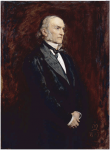 In his later period Millias painted some fine political portraits, inspired partly by Velasquez and Rembrandt. I was particularly taken with The Rt Hon. WE Gladstone, MP, (1878-9). Isolated of all props, Gladstone is austere, almost a visionary. With even looser brushwork and dramatic lighting, this is Millais at his most compelling.
In his later period Millias painted some fine political portraits, inspired partly by Velasquez and Rembrandt. I was particularly taken with The Rt Hon. WE Gladstone, MP, (1878-9). Isolated of all props, Gladstone is austere, almost a visionary. With even looser brushwork and dramatic lighting, this is Millais at his most compelling.
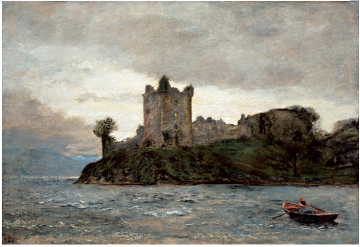
In 1878 Millias was grief stricken at the death of his second son George Grey. He painted 'The tower of strength which stood Four-square to all the winds that blew'. – Tennyson as expiation and it makes an interesting comparison with Constable's Hadleigh Castle, on view at the RA and painted in similar circumstances. Urqhart Castle on Loch Ness is a Romantically ruin, dissolving in uncertain, smudgy paintwork. The overpowering sea and sky are thick with expressive paint, against which the heroic lone oarsman battles.
Millais' last works are an elegy to the Scots landscape. In them the painter achieves a kind of apotheosis.